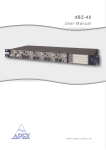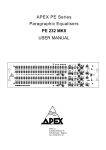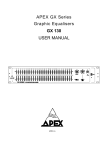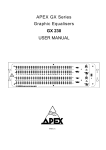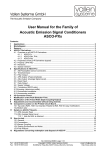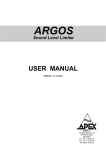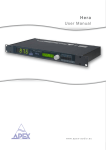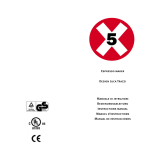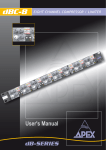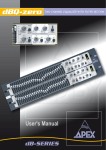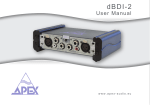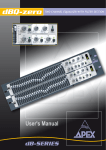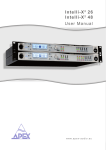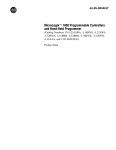Download Apex PE-133 - User manual
Transcript
APEX PE Series Paragraphic Equalisers PE 133 MKII USER MANUAL APEX nv Schoebroekstraat, 62 3583 Beringen - Belgium Tel. +32 89 28 61 91 Contents Section 1 : Contents 3 Section 2 : Introduction 5 2.1 The PE MKII series 5 Section 3 : Performance Highlights 9 Section 4 : Installation 11 4.1 Unpakking the unit 11 4.2 Checking the mains voltage 12 4.3 Setting the mains voltage 12 4.4 Replacing the mains fuse 5.5 The rear pannel 12 13 5.6 Rack mounting 15 Section 5 : Signal connections 1 17 5.1 Input 17 5.2 Output 18 5.3 Grounding 19 Section 6 : The Equaliser 21 Section 7 : General operating instructions 25 7.1 Introduction 25 7.2 Level control, O/load and power 25 7.3 HP and LP filters 7.4 Parametric 26 26 7.5 Graphic equaliser 28 7.6 Specific applications 29 Section 8 : Specifications 31 Section 9 : Maintenance and service information 33 Section 10 : Warranty 35 3 2 Introduction The PE MKII serie The APEX PE MKII series combines a graphic equaliser section with a parametric filter section. Wide-range Butterworth low and/or high pass filters precede the equalisers for added versatility and shaping of the response curve near the edges. The heart of each graphic equaliser section is a bank of 30 bandpass filters at distinct ISO centre frequencies or one filter for each 1/3 octave frequency. Perfectly flat amplitude and phase response is obtained by using our DLT thick film hybrid circuits which surpasses the results and quality of discrete components. DLT stands for Dynamic Laser Trimming: at the factory, each filter of the graphic equaliser is adjusted for optimum 1/3 octave filter centre frequency and bandwidth by means of a special developed trimming algorithm. Adjusting the centre frequency and the Incorporating all filter components on the hybrid circuits has the advantage that the number of soldered connections is largely reduced, boosting the reliability to an extent only exceeded by 5 The controls of the graphic equaliser provides up to 12 dB of reciprocal cut and boost at the distinct ISO centre frequencies. The filters of the PE series preserve optimal filter bandwidth whatever the settings of the controls are. Because of this `constant Q’ circuitry, filter response does not broaden at low cut or boost settings. In this way filter interaction is minimised and the `graphic’ qualities of the equaliser preserved. The individual filters of the graphic equaliser combine smoothly together and result in a continuous response curve, free from The strength of the parametric filters is the possibility to control Q, frequency and bandwidth. A -45 to 15dB of non-reciprocal constant Q is achieved by adding (boosting) or subtracting (cutting) the output of a variable-state bandpass filter from the filter’s input. This technique results in a broader boost than cut curves and makes it possible to create very narrow notches, almost inaudible and therefore without the sound-colouration often found with reciprocal filters. One of the possible applications of those notch filters is 6 All filter and equaliser functions of the PE133MKII are switchable IN and OUT of the signal paths. The complete unit can be bypassed by switching it off. The fail safe relays will react as if there were a mains failure and will link the input of each channel to its corresponding output. The PE133MKII has electronically balanced inputs and balanced, floating output stages. Each output circuit actually simulate a transformer with a 10KOhm impedance to ground for each leg. Both the input and output circuits are factory adjusted for optimum balance at low and high frequencies. This results in increased interference immunity of the unit. The overall gain of each channel of the PE133MKII is variable from -• to +6 dB with the front panel level control. All potential overload points of each channel are continuously monitored by an extremely fast “peak” overload detector, followed by a “peakstretching” circuit for clear indication of overload conditions. The detector thresholds are chosen for approximately 2 dB headroom when the overload led illuminates, giving the user the ability to 7 Performance Highlights 3 PE133MKII • 30 band constant Q precision DLT graphic equaliser. • 3 band constant Q parametric equaliser/notch filter. • Variable LP and HP filters. • Graphic equaliser in-out switchable. • Switchable scale 6/12 dB on graphic equalisers. • 6 dB of gain available. • Extremely low distortion and noise. • True differential input circuitry. • Effective HF interference cancelation on in- and outputs through perfectly HF balanced stages. • XLR in- and outputs. • Accurate “peak-stretching” overload indicators. • Fail safe bypass. • Earth-lift switch. • Power transformer with low flux windings and magnetic screening, reducing magnetic stray field to other units. • Wide mains-voltage range. • Professional parts and construction 9 4 Installation In addition to these operating instructions and the PE MKII equaliser, the packaging also contains : • A power cord (see note for U.K.). • A set of spare fuses. NOTE This apparatus must be earthed. The wires of the mains lead are coloured in accordance with the following code : Green and yellow : Earth Blue : Neutral Brown : Live As the colours of the wires in the mains lead may not correspond with the coloured marking in your plug proceed as follows ; Unpacking the unit The equaliser comes in a cardboard safety box, specially designed for protection of the unit against damage during transport. Save all the packing materials for future use if you ever need to ship the unit again. Please inspect the unit carefully for any signs of damage occurred during transport. Your PE133MKII has undergone stringent quality control inspection and tests at the factory. It left in perfect condition. If damage is found, notify the transport company immediately. Only you, the consignee, may institute a claim against the carrier for damage during shipment. Make sure to retain the damaged 11 Checking the mains voltage Setting the mains voltage Replacing the mains fuse • Check if the voltage selector on the rear of the equaliser indicates the correct supply voltage before connecting the recorder to the mains. • Remove the plug from the wall socket and check if the mains fuse is of the correct rating. • Withdraw the fuse holder from the equaliser by turning the locking screw a half revolution counter clockwise and pull out the fuse holder of the socket • Remove the old fuse and replace with fuse of the correct rating • T630 mA (slow blow fuse) Littlefuse 213.630 for 100/120 V • T315 mA (slow blow fuse) Littlefuse 213.315 for 220/240 V NOTE Delivery position is 220 V / T315mA Wickemann 19195 in all cases 12 The rear panel 1 MAINS FUSE Holds the mains fuse. 2 MAINS SOCKET • Insert the plug of the mains lead into the mains socket. The mains connector is a standard 3 pin IEC connector. The centre terminal of the connector is directly connected to the chassis of the equaliser. • Connect the other end to your mains supply via a wall socket that has a connection to earth!. Mains frequency is 50/60Hz. • For units set at 100 V/120 V: use a UL listed cord set consisting of a minimum 18 AWG, type SVT or SJT three conductor cord, a maximum of 15-feet in length and a parallel blade, grounding type attachment plug, rated 15 A, 125 V. IMPORTANT * • For units set at 230 V(domestic USA): use a UL listed cord set consisting of a minimum 18 AWG, type SVT or SJT three conductor cord, a maximum of 15-feet in length and a tandem blade, grounding type attachment plug, rated 15 A, 250 V. • For units set at 220V/230 V - 240 V (Europe except U.K): use a cord set consisting of a minimum 18 AWG cord and grounding type attachment plug, rated 15 A, 250 V. The cord set should have the appropriate safety approvals for the country in which the equipment will be installed and marked HAR. 3 MAINS VOLTAGE SELECTOR The equaliser is designed to be operated with nominal mains voltages of 115V and 230V. The circuits can tolerate a deviation of ±15% on the mains, covering the range 98V to132V and 195V to 264V. 13 4 SERIAL NUMBER This number is the fingerprint of the unit and should be quoted in any correspondence concerning the unit. 5 SIGNAL GROUND LIFT This switch disconnects the signal ground from the mains and chassis earth. The switch should be used if hum due to ground loops is experienced and will generally solve the problem. 6 Balanced IN Connects the equaliser to balanced outputs. The connector is a female Neutric XLR NC3FD. For wiring details see section 'Signal connections'. 7 Balanced OUT Connects the equaliser to balanced inputs.The connector is a male 14 Rack mounting The PE133MKII is designed for standard 19” rack mounting as well as free standing outside a rack cabinet. The unit requires two standard rack units. Mounting the unit directly over large heat-producing devices may shorten component life and therefore, is not recommended. Ambient temperature should not exceed 50 degrees Celsius when the equipment is powered. Because of the chassis’ mechanical construction, the PE133MKII has no need for support at the rear when mounted in a rack cabinet. This feature facilitates manipulation of the unit while ensuring perfect mechanical stability. Make sure there is enough room for air circulation between different pieces of equipment and through the heatsink at the back 15 16 5 Signal connections For maximum performance, the use of two-conductor shielded cable is recommend. Because the shield does not carry signal, interference between signal current and shield current is minimised in this way. Ordinarily the shield is connected to ground at one end Input The inputs of the equaliser are electronically balanced. The input impedances of the “+” and “-” legs are made equal so that common mode rejection (CMR) is practically independent from the impedance of the driving source. HF and LF trims are provided to optimise the CMR and null-out circuit tolerances. These electronically balanced inputs are compatible with most professional and semi-professional balanced or unbalanced sound equipment. A low pass filter precedes the input stages of the equaliser. When driving the equaliser from a high impedance source, overall frequency response can be compromised because of the low pass filter capacitors. When the source impedance is higher than 2Kž unbalanced or 4Kž balanced, it is advisable to change the cutoff frequency of the input filters. In this case, contact your dealer to make the modifications. Generally, the output impedance of modern audio equipment is 17 Some general rules for input connections : • Although not necessary, because of input circuit symmetry, it is best to always use the “+” and “-” input terminals when wiring the equaliser. In this way, hum pick-up from the open terminal is avoided. • When the PE133MKII is driven from a balanced source, ground the shield at the source-end only and leave terminal 1 (SG) on the PE133MKII disconnected. Wiring of the other input terminals is straightforward. Check carefully for correct phase (relative to output connections). (See figure A and B p20). • When the equaliser is driven from an unbalanced source, connect the shield to the circuit ground of the source and to terminal 1 (signal ground) of the input XLR connector. Depending on whether the circuit ground of the driving equipment is connected to earth or not, it may be advantageous to lift circuit ground from chassis ground on the equaliser using the ground-lift switch. You can experiment with this and leave the switch in the position that gives minimum hum or buzz. Output The output electronics of the equaliser simulate true transformer operation. The impedance to ground from each output terminal is approximately 10 Kž. Output connections are via a standard 3 pin XLR male socket. Because the output is made electronically floating, you may ground eihter terminal 2 (+) or 3 (-) without fear of short-circuiting an op-amp output to ground. Moreover, you loose 6dB of signal Some general rules for output connections : • Always ground the shield at the equaliser side only, by connecting it to terminal 1 (SG) of the XLR socket. • When driving an unbalanced load, connect terminal 2 (+) to the signal input and terminal 3 (-) to the circuit ground of the driven equipment. (See figure B and D p20). • When driving a balanced input, connections are straightforward. Check carefully for correct phase (relative to input connections). 18 Grounding Because it is not always possible to determine whether the equipment connected to the equaliser have their circuit ground connected to earth and because the mains earth is not always of good quality, it is hardly possible to give general rules for • One and only one ground path should exist between each piece of equipment. • The circuit ground of the equaliser should not be left floating. A ground loop generally causes a steady hum. If you encounter a ground loop, you can often break it using the ground-lift switch on the rear panel. When using the ground lift switch, the circuit ground of the equaliser is disconnected from the chassis ground. Chassis ground is always connected to earth for safety reasons. Signal ground remains connected to terminal 1 of the XLR sockets. The input/output/supply board of the equaliser is provided with place for adding a resistor and a capacitor (R107,C107) for those who do not wish to completely disconnect the chassis and circuit grounds. Providing a small ceramic capacitor between the two grounds can be helpful for solving HF buzz problems, often encountered when using mains ground. The figures below shows some grounding schemes for the equaliser. If you follow these figures while setting up your system and hum or noise appears, don’t be afraid to experiment. Just keep safety earth connected to the chassis of the equaliser. A ground loop consists of two connections to ground, so there is always another solution than to disconnect the chassis of the 19 Figure A Figure B Figure C Figure D 20 6 The Equaliser See fold out at the end of the manual POWER When pressing the power button, AC mains is applied to the unit. The red led below the power switch illuminates as you switch on the apparatus. The fail safe relays will open, switching the filters between the input and the output of the unit. When 1 switching power off, the fail safe relays will link the input of each O/LOAD The O/LOAD indicator illuminates when the peak signal voltage anywhere in the unit exceeds +18dBm. This level is about 2 dB below clipping of the equaliser’s internal circuits. The overload led is commanded by a “peak-stretching” circuit, for better 2 visualisation of overload conditions and will light for LEVEL dB The LEVEL control adjusts the input level to the equaliser and filter sections of the unit. Being preceded by the input stage, the level control does not permit to adjust signal level in this part of the circuit. The equaliser has 6dB of available gain and can 3 LP be used as a low noise and distortion gain make-up amplifier. The level control lets you adjust gain between -• to +6dB in a The LP filter has a tuning range of 2 to 40KHz. Like the HP filter, the LP filter has a butterworth 12dB/octave response. This filter is useful for rejecting unwanted high frequency noise and 4 21 HP The HP filter has a continuously variable cutoff frequency of 15 to 300Hz. The filter has a roll-off slope of 12dB/octave and is of 5 the Butterworth type for maximally flat response. It is particularly useful in situations where potentially harmful subsonic signals IN/OUT These switches are switching the corresponding filters in/out the signal path. It is advised to leave the filters in the signal path to 6 protect the system against subsonic signals ore high frequency GAIN The GAIN controls of the parametric/notch filters adjust the 7 centre frequency gain of the corresponding parametric filter. Q The Q controls adjust the Q of each band. Setting Q to maximum result in a narrow band operation while a minimum Q 8 result in a broadband operation. Calibration tolerance of the Q FREQ. The frequency control adjusts the centre frequency of the filter. In combination with the multiplier switch, the centre frequency can be positioned anywhere in the audible spectrum. Calibration 9 tolerance of the frequency controls is about ± 10...20%, MULTIPLIER The multiplier switch selects the range of the frequency control : 0.1 corresponds to a frequency range of 18 to 200 Hz 1 corresponds to a frequency range of 180 to 2000 Hz 10 10 corresponds to a frequency range of 1k8 to 20 kHz The vernier control is used in combination with the frequency 11 The IN/OUT switch activate or deactivate the corresponding IN/OUT 12 22 control and is used for fine tuning the position of the centre parametric filter function. SLIDERS 13 IN/OUT 14 SCALE 15 NOTE The sliders of the graphic equaliser allow centre gain adjustment for each of the indicated centre frequencies. The IN/OUT switch activate or deactivate the corresponding graphic equaliser section. The SCALE switch switches the range of the corresponding graphic equaliser section to 6dB or 12dB full scale. Note :The rotary controls of the PM133MKII are high quality conductive plastic potentiometers. However, calibration accuracy of these controls is only modest. Indications on the front panel therefore are principally intended 23 General operating instructions Introduction 7 If you are not familiar with equalisers, the best thing to do before first turn-on is to put all controls in their central position. When the unit is not powered or the power supply fails, the fail-safe relay of the equaliser links input and output. By putting the controls in their central position, you make sure that the overall gain of your system is not changed when the fail-safe relay activates. This is a good starting point for the exploration of the equaliser’s functions. Once all mains and input and output connections are made correctly, switch the unit on by pressing the “power” switch. After app 0,2 seconds the fail-safe relay will activate and thereby link the unit in the signal path. The graphics on the equaliser’s front panel illustrate the different functions of the unit and make it ergonomically pleasant to work Level control, The level control is preceding the filter section of the equaliser and O/load and power levels the input signals of the filter section. The input stage of the equaliser is located before the level control. The level control has thus no effect on the levels in the input stage. In case the overload led illuminates and decreasing the level with this control has no effect, it probably means that the input stage is in overload. The only solution to this problem is lowering the signal level at the input of the unit by lowering the output of the driving equipment or by adding an external loss pad to the input wiring. Of course the power switch is for turning the unit on and off, but if the system is set up well (LEVEL at 0dB...), it can be used as a bypass for the complete equaliser, making use of the fail-safe 25 HP and LP filters The HP filter has a continuously variable turnover frequency from 15 to 300Hz. The filter has a roll-off slope of 12dB/octave and is of the Butterworth type for maximally flat response. It is particularly useful in situations where potentially harmful subsonic signals are likely to cause speaker or amplifier overload. Phono cartridges and wind in microphones are examples of sources that can produce excessive subsonic outputs. It is advised to leave the HP filter in the signal path whenever possible. Adjusted for a 25Hz roloff, it will not have a dramatic effect on sound while providing serious protection against overload. The LP filter has a tuning range of 2kHz to 40kHz. Like the HP filter, the LP filter has a butterworth 12dB/octave response. This filter is useful for rejecting unwanted high frequency noise and out of band signals that might cause tweeter damage. As with the HP filter, it is advised to leave the LP filter in the signal path. Setting the control for a 23KHz roloff will protect your system while preserving musical integrity. Deliberately narrowing the bandpass by adjusting the HP filter for a 300Hz roloff and the LP filter for a 2...3KHz roloff, will produce a telephone-channel-like sound. Parametric If you have never used a parametric equaliser before, the best thing to do is to experiment with actual program material. It is hardly possible to describe the physical perception of certain equaliser settings. It is therefore better you hear it for yourself. For this reason, we will limit ourselves in this section to some general guidelines for using these filters. The bandwidth of the parametric filters is adjusted with the central “Q” controls. “Q” calibration of these controls was chosen for simplicity : The relationship between -3dB bandwidth (BW), Q and centre frequency Fc is given by following simple formula : Fc BW = —— Q 26 Boost a filter and discover the contrast between the subtle shelving effects available from broadband operation ( Q minimum ) and the ringing, coloured sound you get from narrowband peaking ( Q maximum ). Be careful when boosting frequencies outside the hearing range. High Q boosting at high frequencies is almost inaudible and can cause tweeter damage. Woofers, specially if they are mounted in horns or bass-reflex enclosures, should not be driven with frequencies below the cabinet cutoff frequency, to avoid destruction. When you cut a section, you will find out that narrowband dips are essentially inaudible. You can experiment with this using the IN OUT switch for comparing processed and unprocessed sound. Infinite notches are very useful for removing unwanted frequency components like hum, without degrading sound integrity. Adjusting a filter for infinite notching at maximum Q is not a simple job and even with the slow-motion controls, frequency adjustment can be a problem. This is caused by the fact that filter edges get steeper, the more you attenuate. Also reliability of the notch settings can pose a problem. This can become problematic in permanent installations. In such cases it is better to use a somewhat lower Q setting when infinite notching. You will find out 27 that even at lower Q these non reciprocal filters remain essentially inaudible. In the overlapping regions, between two filter sections, you can adjust two adjacent sections to the same frequency. Because of the perfect combining response of the filters, responses are added. This is another way for building a deep, less sensitive notch. You can adjust two -15dB filters to get a 30dB notch and because of Graphic equaliser The centre frequencies of the graphic equaliser are chosen for perfect filter interpolation. For some frequencies this means a slight deviation from the ISO proposed centre frequencies. The maximum deviation is about 2% so there should be no problem when using the equaliser in combination with commercial real time analysers that, generally, use the ISO centre frequencies. The 30 controls of the graphic section provide you with a lot of possibilities for shaping sound. In doing so, it is best to regard following principles : • It is generally better to attenuate peaks, rather than to boost the surrounding frequencies to the same level. Noise will be lower and the sound will be more natural in this way. • Do not attempt to correct narrow peaks or dips with the graphic section. Use the parametric filters for this purpose. These are designed for narrowband operation and are much more versatile . • Do not use the graphic equaliser as a gain fix-up device. It is far better to use the 6dB of available gain from the LEVEL control than to put a lot of equaliser controls in the boost position. 28 Specific applications This part of the manual describes very specific suggestions on how to use the PE133 in different applications. We recommend that you read these. The information contained in each may inspire you for setting-up your system. The proposed equaliser settings are only indicative and are no guarantee for successful implementation in your system. Room equalisation The PE133 is very well equipped for sound system equalisation and adaptation of the system response to suit environmental needs. The parametric filters can be used to suppress the major ring modes of a room. This is most easily and safely done if the system is provided with a limiter or compressor in the main signal path to control the gain of the system once feedback occurs. Put the bandwidth controls of the parametric filters in their centre position. This will make it easier to find the exact frequency at which feedback occurs. Afterwards, while fine-tuning, the bandwidth of the filters can be reduced (higher Q setting) to minimise the loss of audio information. Increase the gain of the system until it feeds back at a single frequency. This is the major ring mode. Make sure that from the moment feedback occurs, the compressor or limiter is active. Feedback is a regenerative process and it will become stronger and stronger until the system goes into nonlinearity. By that time speaker failure could have occurred. Make a rough estimation of the frequency at which feedback occurs and notch-out the ring mode by adjusting the gain and frequency controls of the appropriate filter section. Normally it is not necessary to use the infinite notching capability. Remember that the filter gets broader when the attenuation increases. It is therefore better to adjust the gain control for a headroom of app. 5 to 10 dB below the feedback point. This procedure can be repeated for the suppression of other ring modes, if they appear. Normally after a few ring frequencies are eliminated, the “point of diminishing returns” is reached and further effort is not very rewarding. The graphic equaliser section can now be used to further tailor the 29 system response and to compensate for deficiencies in the room acoustics. Conference equalisation Low frequencies are attenuated for decreasing the effect of windhowl in the microphone, using the high pass filter with a 30 Hz cutoff. Hum is easily suppressed with a parametric filter in the notch mode. For example : Adjust the LF parametric filter to produce a notch at 50Hz with a Q of 3. Create, with the graphic section, a slight boost in the vocal range for increased presence of 30 8 Specifications INPUT: • Electronically balanced • Absolute overload point : +22dBu • Impedance: 10 Kž (each leg) • equal impedance for “+” and “-” legs CMRR better than 65dB (20Hz-20KHz) • XLR-3 type connector connections : 1 signal ground; 2 hot (+); 3 cold (-) OUTPUT: • Electronically balanced and floating, simulating transformer output with app. 10 Kž to ground impedance for each leg • • Max level: >+21dBm into 600 ž Impedance: 51 ž (each leg) • Output symmetry balance better than 65dB (20Hz-20KHz IEC) • XLR-3 type connector connections : 1 signal ground; 2 hot (+); 3 cold (-) PERFORMANCE: • Frequency response: +0 -0.5dB, 20Hz-20KHz (graphic eq IN) PE133MKII • THD: <.01% (20Hz-20KHz) • Noise: <-92dBm (typ. -94dBm), graphic and parametric equalisers in circuit (0dB settings) measurements : 22Hz-22KHz RMS unweighted • Level control: -• to +6dB • • Level control ‘0dB’ cal. accuracy: +-0.2dB (overall gain input to output) Overload indicator: lights for approximately 200ms if the instaneous peak voltage at 31 any point in the equaliser comes within 2dB of clipping FILTERS: Graphic equaliser: • 30 ISO centre frequencies: 25Hz-20KHz 1/3 octave • Centre frequency tolerance: ±1% (typically better than ±0.5%) • • Q tolerance: ±1% Max boost/cut: 6 or 12dB ±0.5dB reciprocal • Switchable Parametric filters • Tuning ranges: 18-200Hz,180Hz-2KHz,1800Hz-20KHz • On each band vernier control: ±10% of main frequency control. • Range of Q adjustment: 0.5 to 8 • Range of level adjustment: -• to +15dB (typ -45 to +15.5 dB) non reciprocal. Smaller cut than boost curves through addition and substraction of parametric bandpass filter output to filter input • Each filter individually switchable High pass filter: • Frequency range: 15-300Hz (-3dB frequencies) • Type: maximally flat 12dB/octave • In/out switchable Low pass filter: • Frequency range: 2-40KHz (-3dB frequencies) • Type: maximally flat 12dB/oct • In/out switchable POWER REQUIREMENTS: • Voltage: 110/120/220/240V 50/60Hz • • Consumption: 20VA equaliser IEC type connector SIZE: • 482mm(19 inch) wide x 89mm(3.5 inch) high x 255mm(10 inch) deep equaliser WEIGHT: • 32 app. 5 Kg Maintenance and service information Preventive maintenance 9 Preventive maintenance consists of cleaning and visual inspecting the unit. When accomplished regularly, preventive maintenance may prevent malfunction and lengthen the apparatus life. The severity of the environment in which the equaliser is used determines the required frequency of preventive maintenance. Regular cleaning prevents accumulated dust from penetrating potentiometers. The front panel can be cleaned with a soft cloth or a small softbristle brush. The brush is particularly useful for dislodging dirt on and around the controls and inside the slider slots. Dirt that remains can be removed with a soft cloth dampened in a mild detergent-and-water solution. Do not use strong solvents as they may damage the paint, the screened lettering or the plastic control knobs. Be careful not to let detergent leak into the potentiometer slots as it may damage the carbon resistance tracks. The rear panel can be cleaned in the same way as the front panel. The top cover minimises accumulation of dust inside the unit and should normally be in place when using the equaliser. Dirt on components acts as an insulating blanket, preventing efficient heat dissipation. It also provides an electrical conduction path that Corrective Corrective maintenance consists of component replacement and maintenance repair of the unit. Unless you are a highly skilled technician, do not try to repair this unit. Moreover, specialised components are used in this apparatus and for several of them it is very doubtful if you could find a correct replacement. Therefore, contact your dealer in the event of failure. He (or she) has notice of the Apex authorised service centres and can advice you about what to do. Copy the service request form on the next page, fill it out and ship it with the defective unit. It will help the service technician to localise the problem. It is often more expedient to call your dealer or our factory 33 SERVICE REQUEST FORM Please copy and complete this form as completely as possible and return it to Apex or an authorised Apex service centre together with the defective unit. Name/Company:........................................................................................................................................... Adress:............................................................................................................................. .............................................................................................................................. Telephone:........................................ Country:................................................................ Model No:......................................... Serial No:.............................................................. Purchased from:............................... Date:...................................................................... • Describe symptoms of malfunction: • Under what conditions does the malfunction occur? A. All the time B. After a while C. At high signal levels D. At high temperatures E. Other (please explain) • How often did the problem occur? • What did you do to isolate the problem to this unit? • Further comments 34 WARRANTY Summary We, APEX nv Bosdel 52 3600 Genk Belgium warrant to you, the original purchaser and any subsequent owner of this Apex product, for a period of one year from the date of purchase by the original purchaser that the product is free of defects in components and factory workmanship under normal use and service. The date of purchase is the date appearing on the first end-user’s bill of sale or other proof of original purchase from an Items excluded We are not responsible for product failure caused by misuse, from warranty accident or neglect. This warranty shall not be applicable to any product on which the serial number has been defaced, altered or removed. It does not cover damage to other components, connected to the Apex product, resulting from Apex product failure. This warranty shall be considered void if this product is subjected to repair work or alteration by persons other than authorised by Apex in such a manner as to injure, in the sole judgement of Apex, the performance, stability, reliability or safety Our commitment During the warranty period, when failing to perform as specified, Apex will undertake to repair or at its option, replace this product at no charge to its owner, provided the unit is returned, shipping pre-paid, to the factory or authorised service facility. You must notify us of your need for warranty service, preferably by filling in the service request form and returning it to us. We will give you notice of the authorised service centres to whom you may deliver the product or we will give you an authorization to return it to the factory. All components must be shipped in a factory pack, shipping prepaid. If needed replacement packing can be obtained 35 from us. Corrective action will be taken within a reasonable time of the date of receipt of the defective product by us or the service centre. If the repairs made by Apex or the authorised service centre are not satisfactory, notify Apex or the service centre immediately. Repairs Product changes We reserve the right to change the design on any product without prior notice and with no obligation to make corresponding changes in products previously manufactured. 36































